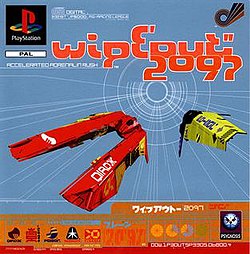Wipeout 2097
| Wipeout 2097 | |
|---|---|

European PlayStation cover art
|
|
| Developer(s) | Psygnosis |
| Publisher(s) | Psygnosis |
| Programmer(s) | Stewart Sockett, Chris Roberts, Nick Kimberley |
| Artist(s) | Pol Sigerson, Ashley Sanders, Nicky Westcott, Dave Crook, John Harris, Eve Penford, Darren Douglas, Jeff Bramfitt, Mick Harrison |
| Composer(s) | Tim Wright |
| Series | Wipeout |
| Platform(s) | PlayStation, Windows, Sega Saturn, WarpOS, Mac OS |
| Release | |
| Genre(s) | Racing |
| Mode(s) | Single player, two-player (via PlayStation Link Cable), multiplayer (via IPX, , modem, or null modem) |
| Aggregate score | |
|---|---|
| Aggregator | Score |
| GameRankings | 94.75% |
| Review scores | |
| Publication | Score |
| Edge | 8/10 |
| GameSpot | 8.6/10 |
| IGN | 9/10 |
Wipeout 2097 (stylised wipE'out"2097; released as Wipeout XL in North America) is a 1996 futuristic racing game developed and published by Psygnosis. It is the second instalment released in the Wipeout series, and is the direct sequel of the original game released the previous year. It was originally released in 1996 for the PlayStation and Microsoft Windows, and in 1997 for the Sega Saturn. It was later ported by Digital Images to the Amiga in 1999 and by Coderus to Mac OS in 2002.
Whereas the original game introduced the F3600 anti-gravity racing league in 2052, Wipeout 2097 is set over four decades later and introduces the player to the much faster, more competitive, and more dangerous F5000 AG racing league. The game introduced a new damage interface and new weapons and tracks. The Sega Saturn version supported analogue control by using its 3D Control Pad, whereas the PlayStation version supported analogue control only through using the optional Negcon twist controller.
The game received generally positive reviews from critics, who praised the game for its unique blend of trance music and designer logos and cited that Wipeout 2097 was the beginning of a new trend in gaming to tap into popular culture and other arts. IGN ranked the game as the 13th best PlayStation game of all time in 2002.
Gameplay did not differ much from the previous title. Aside from the different circuits and new weapons, the fundamental aspects were kept. Pilots would race each other or computer-controlled A.I. opponents, to finish in the highest position possible. To help them achieve this end, weapons were provided.
Though the crafts move at very high straight-line speeds, Wipeout takes its inspiration from Formula 1 breakthroughs by aspiring for even greater turning speeds. Using the Formula 1 parallel, rather than using aerodynamics to increase wheel grip by down-force for faster turning speeds, Wipeout uses a fictionalised method of air braking for ever greater turning force. Just moving a craft left or right alone is very responsive, but by applying an air-brake in the direction of movement, players zip around very tight turns at near top speed, including those greater than 90 degrees. By applying an air-brake, the turn starts out gradually but as it continues, change in direction increases sharply. Where necessary, the player may also use dual air-brakes for rapid deceleration, typically used if the pilot has flown off the racing line in tight corners and needs to steady. The player can also take on damage from enemy fire and be blown up, but the ship can be "recharged" to health at the pit stop in exchange for a precious few seconds of the race.
...
Wikipedia
